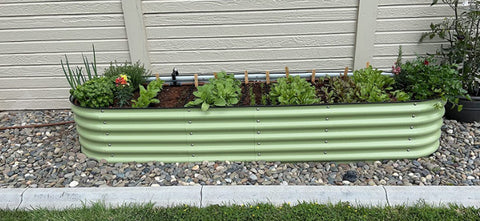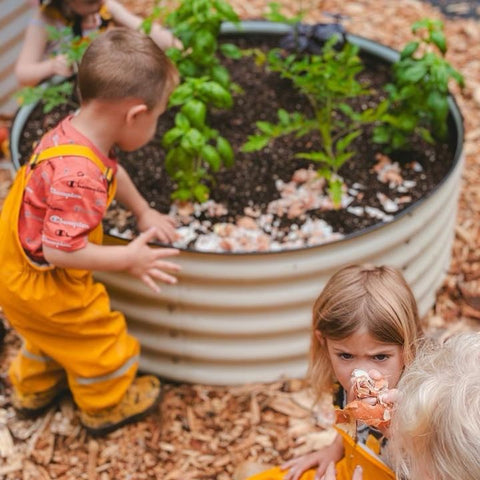The knowledge from can You Put Bark Or Mulch on The Bottom of A Raised Garden Bed?
If you are considering building or installing any new raised garden beds on your property this year, you may think the best way is to fill them with soil. But have you considered filling raised garden beds with tree bark or mulch? Or put logs, branches, sticks, or sawdust under the bed?The knowledge for for raised garden beds.
Bark, mulch, logs, branches, and sawdust are important additions to the bottom of the elevated garden bed. They will decompose over time, improving drainage while adding nutrients to the soil, and they will also minimize the amount of bulk or bagged soil required to fill raised garden beds.
Contrary to the idea of some people, it is entirely possible to fill a raised garden bed with bark or mulch.
In fact, doing so is actually beneficial for your garden, as it creates a mini huge cultural effect in your raised garden bed, which will help nourish your plants over time
When filling new raised garden beds, you should carefully consider filling them with bark, mulch, logs, branches, sticks, sawdust, or other compostable materials.
One of the benefits of using bark or mulch (or any other wood debris) on the bottom of a raised garden bed is its cost effectiveness.
As a cheaper alternative to filling the entire bed with soil, adding bark or mulch to the bottom can save you a lot of money, especially if you cannot obtain high-quality bulk soil and must purchase bagged soil from your local garden center or home improvement store.
Wood debris decomposes over time, providing various nutrients to the soil and improving soil structure.
But don't worry. As wood continues to decompose, it will release nitrogen along with calcium, phosphorus, potassium, and low levels of magnesium, sulfur, and other nutrients back into the soil. In the long run, these nutrients will work wonders for your plant.
This means that when wood decomposes underneath, you need to be patient with the soil and select plants that have short roots and are not diazo feeders in the first year of decomposition.
Remember that the decomposition process may vary depending on the material you place in a raised garden bed, container, or flowerpot.
Softwoods such as pine and cedar decompose faster than hardwoods (ash, maple, oak, walnut). In addition, your irrigation practices, as well as outdoor temperature and microbial activity, will affect the rate of decomposition of bark or mulch.
As a general rule, you can assume that it takes at least 6-12 months for bark, mulch, or sawdust to decompose and fully integrate into the soil.
Similar mini giant cultural effects can be achieved when using bark, mulch, or wood fragments on a raised garden bed. By layering wood chips or other types of wood on the bottom of a raised garden bed, gardeners can create a nutritious environment for their plants. This is particularly beneficial in raised garden bed gardening, where in hot summers the soil quickly dries out and nutrients run out over time.

What should I put on the bottom of the raised garden bed?
Now that I have provided you with an overview of using bark, mulch, and sawdust in the garden, let's take a quick look at what should be placed at the bottom of the raised garden bed before starting to load sawdust.
The key to gardening with a raised garden bed is to exclude as much invasive grass and weeds as possible from the raised garden bed. You can start by weeding. But after you do this, you will need cardboard. A lot of cardboard.
Cardboard is an excellent material for elevated garden beds - whether placed inside a raised garden bed or layered under the bed - for several important reasons:
First of all, it is very suitable for suffocating and killing grass, which can be a problem for gardeners.
Secondly, cardboard is an effective weed inhibitor that prevents sunlight from reaching weed seeds, thereby inhibiting their growth.
Third, it is a cheap alternative to landscape fabrics, decomposing quickly and adding organic matter to the soil.
Fourth, cardboard (once decomposed) allows the roots of plants to obtain nutrients from the native soil, which is particularly important if you build a garden on poor soil (such as the hard packaged clay on my property).
Fifth, as cardboard decomposes and disappears, earthworms and other beneficial microorganisms eventually migrate from native soil to the raised garden bed soil.


When using cardboard on an elevated garden bed, you need to ensure that it is free of stickers, labels, and tape, and you need to lay a thick layer of cardboard and overlap the edges to prevent grass and weeds from growing through any gaps.
If you have burrowing pests on your property, you also need to cut a piece of hardware cloth to adjust the size and layer it on cardboard to prevent them from damaging your plants.
In short, cardboard is an economical and sustainable material that can help you create a healthy growth environment for plants. If you are looking for a simple and environmentally friendly way to prepare an elevated garden bed, please consider using cardboard as your preferred solution.
What is the cheapest way to fill a raised garden bed?
Of course, once you place the cardboard on or under the raised garden bed, you must figure out what to do next.
Assuming you are building or installing a larger raised garden bed, did you know that you can put various compostable organic materials into it?
Banana peel
branch
compost
Egg paper box
Eggshell
Fish pomace
Fruit residue
christmas tree
coffee strainer
Coffee grounds
Dead Indoor Plants
flower
Garden plant waste
Grass dust
Hay
Jack O'Lantern
Spam
Kitchen residue
leaf
Livestock manure
Log
Towel gourd
cover
newspaper
Paper documents
napkin
tissue
Pet Fur
Pine needle
Potted soil
Rope or twine
straw
Stick or branch
tablecloth
Tea bag
Tea
Toilet roll
Wine cork
All of these materials will decompose over time, so continue to stack them in the new raised garden bed, and then place 4-6 inches of soil on the raised garden bed.
In the first year, you need to stick to using shallow rooted plants because your raised garden bed doesn't have much soil, but next year, the decomposition process will have time to work, so you will notice that your bed is filled with a lot of organic soil.
